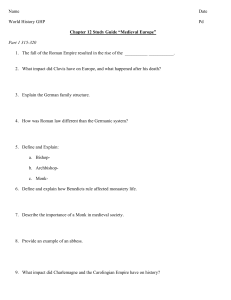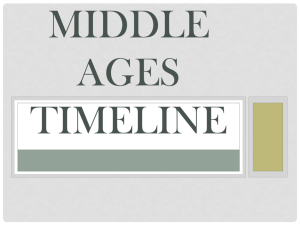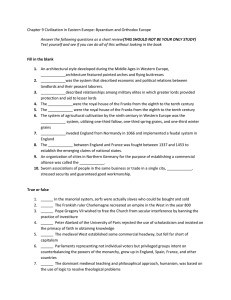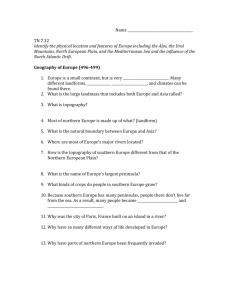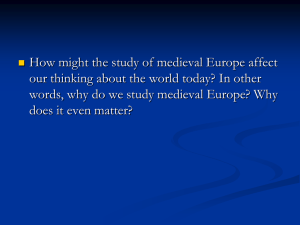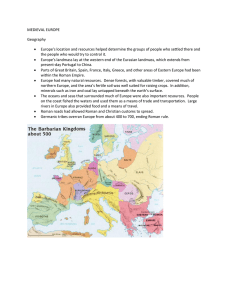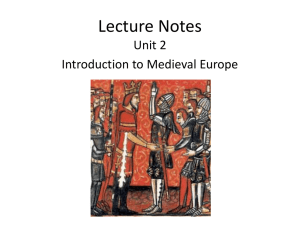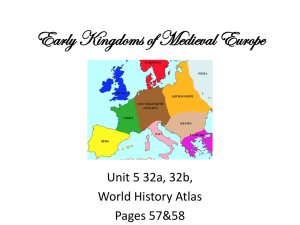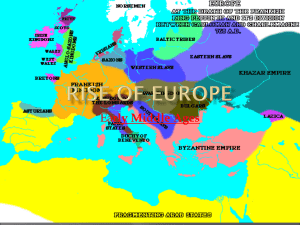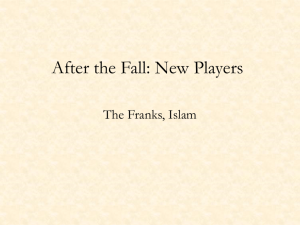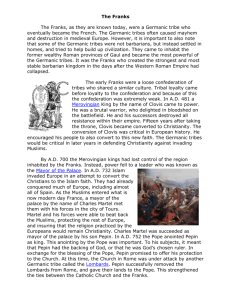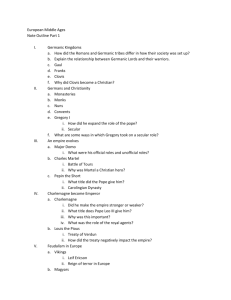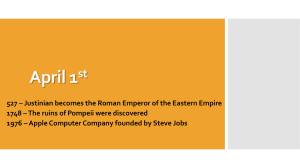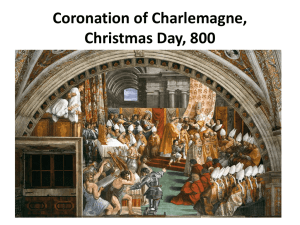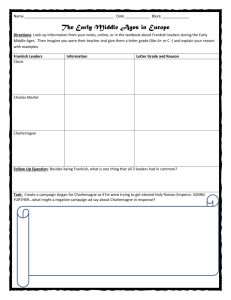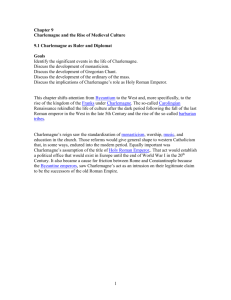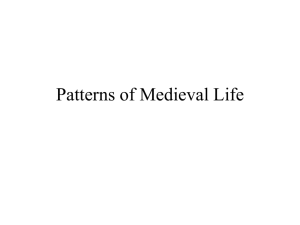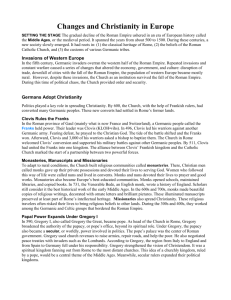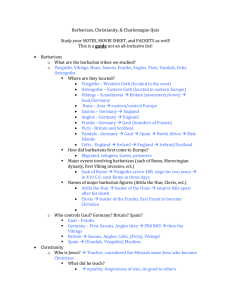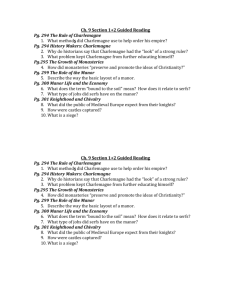Chapter 7 section 1 and 2 notes
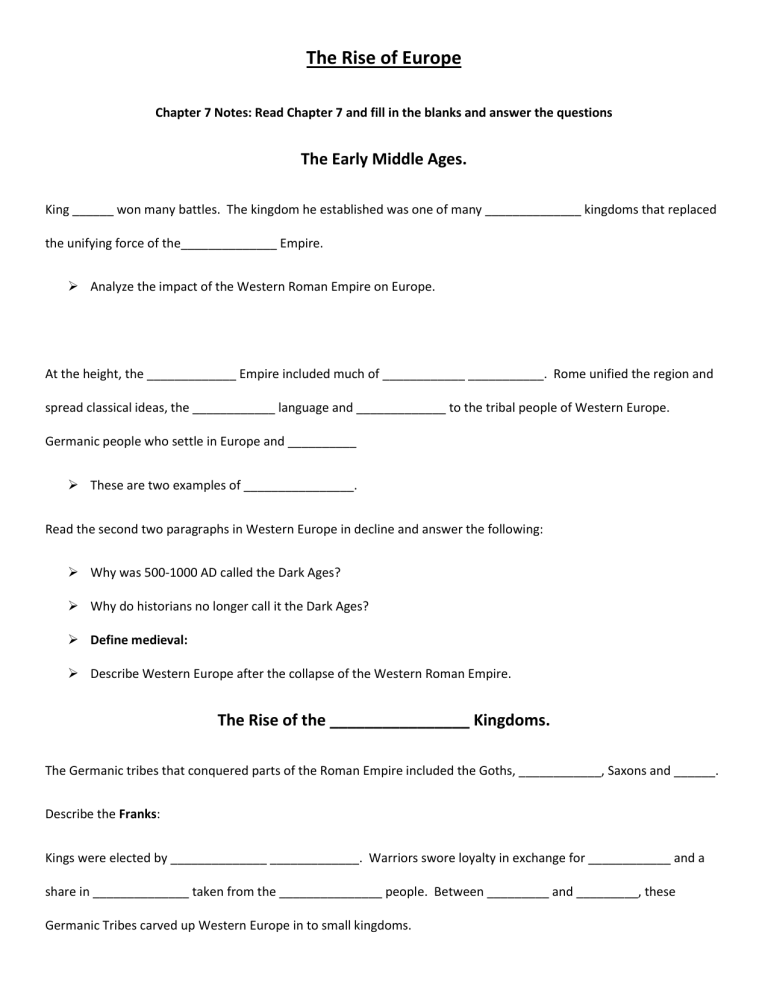
The Rise of Europe
Chapter 7 Notes: Read Chapter 7 and fill in the blanks and answer the questions
The Early Middle Ages.
King ______ won many battles. The kingdom he established was one of many ______________ kingdoms that replaced the unifying force of the______________ Empire.
Analyze the impact of the Western Roman Empire on Europe.
At the height, the _____________ Empire included much of ____________ ___________. Rome unified the region and spread classical ideas, the ____________ language and _____________ to the tribal people of Western Europe.
Germanic people who settle in Europe and __________
These are two examples of ________________.
Read the second two paragraphs in Western Europe in decline and answer the following:
Why was 500-1000 AD called the Dark Ages?
Why do historians no longer call it the Dark Ages?
Define medieval:
Describe Western Europe after the collapse of the Western Roman Empire.
The Rise of the ________________ Kingdoms.
The Germanic tribes that conquered parts of the Roman Empire included the Goths, ____________, Saxons and ______.
Describe the Franks:
Kings were elected by ______________ _____________. Warriors swore loyalty in exchange for ____________ and a share in ______________ taken from the _______________ people. Between _________ and _________, these
Germanic Tribes carved up Western Europe in to small kingdoms.
In 486 AD, Clovis, _________ of the Franks, conquered the former Roman province of _____________ (which later became ____________). Clovis took an important step when he converted to _________________, the religion of his subjects in ______________. He gained Gaul’s support and a powerful ally in the ________, leader of the ____________
Church of ____________.
A Muslim Empire Threatens Europe
A new power was emerging across the ________________. The religion of Islam began to spread in the ___________ after beginning in ______________. Muslims or believers of _____________, created a huge expanding ____________.
The Muslim Army began to cross into France, and Frankish military leader Charles ______________ rallied Frankish warriors. The Frankish Christian warriors won at the Battle of _____________. They believed that the victors was a sign that ______________ was on their side. Despite the defeat, the Muslims began to rule ______________.
Why were the Christian leaders concerned about the Muslim presence in Spain?
Why would the Europeans continue to trade with Muslims?
How did the win at the Battle of Tours against the Muslims add to the Franks belief in Christianity?
The Age of Charlemagne
Charlemagne united _____________ Europe and he built and empire reaching across ______________, ____________ and part of _____________. Charlemagne spent much of his 46 year reign fighting the _______________ in _________.
Complete the following chart writing at least 2-3 sentences per section:
The Age of Charlemagne
Heading Main Idea
Describe the Pope Leo the III’s relationship with Charlemagne and how they supported one another:
How did this lead to the separation of Eastern and Western Europe?
How was Charlemagne able to unite Christian Europe?
Define missi dominici:
Europe After Charlemagne
The Treaty of Verdun, signed in August 843, was the first of the treaties that divided the Empire into three kingdoms among the three surviving sons of Louis the Pious, the son and successor of Charlemagne.
Who are the Magyars?
Who were the Vikings?
Describe the invasions of Europe that took place after Charlemagne’s death:
Section 2: Feudalism and the Manor Economy
Define Feudalism:
Describe the orders of medieval social hierarchy:
Define vassals:
Mutual Obligations
The _____________ and _____________ relationship between lords and vassals was based on the exchange of land for
___________ and military service.
Why would the lords agree to this exchange?
Why would the vassals agree to this exchange?
Define feudal contract:
Define fiefs:
A fief included _________________ to work the lands.
The World of Knights and Nobles
For medieval nobles, _______________ was a way of life. Rival lords battled constantly for ______________.
Define Knight:
What was the process of becoming a knight?
Define tournaments:
Why would a knight engage in a tournament?
Read Castles and Defense section and examine the map Defending a Castle on page 34. Then answer the two think critically questions.
1.
2.
Explain the role of Noble Women in terms of 1) Restrictions and 2) Power
1.
2.
Read the Biography on Page 36 and answer the question: How did Eleanor of Aquitaine expand the usual role of medieval women?
Define Troubadours:
Define Chivalry:
Define manor:
Define serfs:
How did manors and serfs add to and solidify the feudal system?
In 4-6 sentence summarize the section: A Self Sufficient World on page 37.
Describe Peasant life.
How did the manor system work?
